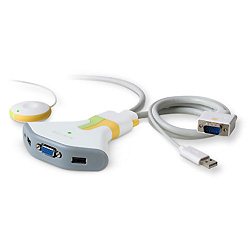Belkin Flip USB KVM Switch
![]()
![]()
![]()
![]()
![]()
![]()
![]()
![]()

A simple device with a pedestrian function, the Belkin Flip is noteworthy because it works reliably where so many lesser — and albeit cheaper — devices fail, break or emit blue smoke. The Flip is a KVM switch — it will allow you to connect two computers to a single monitor, keyboard, mouse and speaker set, and flip instantly between them.
You’ll probably want a device like the Flip if you need to access more computers than your desk space would otherwise allow, or if you’d like to connect your laptop to a full-size monitor and keyboard from time to time. It’s also useful if you get a new computer, and you anticipate needing extended access to your old one.
It’s worth noting that KVM switches with more than two sets of ports exist — you can access a room full of machines with a single monitor and keyboard — but these things are way more complex and expensive than a Flip. You’d also have to get pretty far out into the uncharted reaches of cyberspace to want one.
Our Flip was bought after unpleasant experiences with a number of its lower-priced competitors — mysterious boxes with hitherto unheard-of manufacturers and instructions in badly translated pseudo-English. By comparison, the Flip appears well-thought-out, professionally constructed and nicely documented.
Installing a Flip involves moving a fair number of cables around, but it’s hardly quantum physics. Plug your monitor, mouse, keyboard and speakers into the flip. Plug the corresponding monitor, mouse, keyboard and speaker connectors from the flip into each of the appropriate connectors on the two computers to be accessed, and plug in the connectors for the large, friendly Flip button. Find somewhere inconspicuous to hide the huge nest of mutant snakes that the Flip will have thus become. Power up.
Unless you’re unusually dangerous around technology, it’s pretty well impossible to mangle this one.
Once it’s working, you can boot up both the computers connected to a Flip, and switch between them by touching the large round Flip button, illustrated at the beginning of this review. The Flip button has an LED that changes color to indicate which computer is active. The color of the LED — either green or orange — corresponds to the colors of the two connector sets which join the Flip to its host computers.
This arrangement touches on one of the few omissions in the Flip’s documentation. The Flip doesn’t remember where it was last set when the computers it’s connected to power down for the night. Rather, it always comes up with the orange connectors enabled. Make sure you connect the system you want to access most of the time to the orange side of the Flip.
In practice, there are several considerations in using a Flip to switch between contemporary PCs, to wit:
- In switching between Windows PCs with USB-based interface devices, Windows will think that the sudden disappearance and subsequent reappearance of your toys, as the Flip dances between universes, as a good sign that the hardware in question is malfunctioning. Windows will insist on popping up warning balloons to this effect. You’ll need to open the Device Manager in the System applet of the Windows Control Panel, locate a Universal Host Controller item and enable the Don’t Tell Me About USB Errors item in its Advanced tab. This is a bit of an issue, as doing so will also prevent Windows from Windows from notifying you about genuine USB errors, should any arise. They rarely do.
- Flipping between computers wherein at least one of them is running Windows will typically involve a post-flip wait of several seconds while the newly-enabled mouse and keyboard reinitialize themselves. The flipped-to desktop will become visible immediately.
- If one of the computers connected to the Flip is running Linux, you’ll probably need to have the Flip flipped to it while it’s booting up, as most distributions of Linux investigate the hardware they’re being asked to run with as they awaken. If the Flip is looking elsewhere, your Linux computer won’t find any keyboard or mouse hardware, and it will go into vapor lock.
None of these are serious deal-breakers, as long as you know what the little man behind the curtain is really up to.
In addition to the Flip’s mechanical switch, you can download Windows and Macintosh versions of an application to let you flip between the computers connected to the Flip from your desktop.
We were impressed with the Flip — it does what it does well, and with a minimum of setup issues or run-time problems. It costs about twice what a lesser KVM switch would, but its ease of installation and lack of spontaneous combustion arguably makes it worth the price. Its large, funky switch button is unquestionably a bonus.